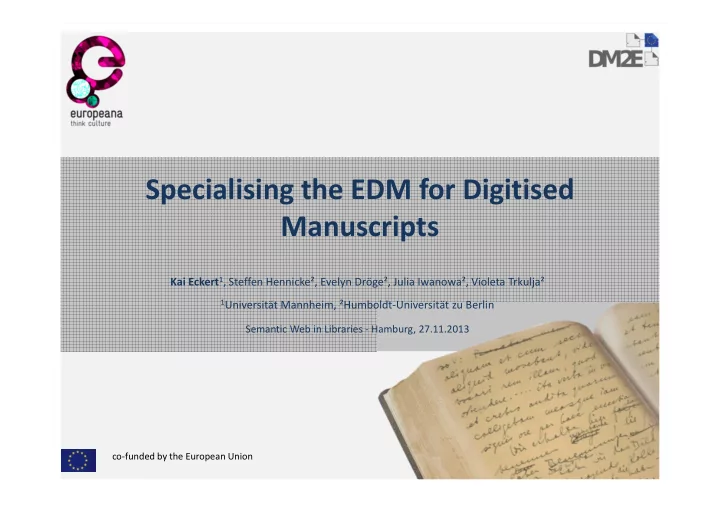

Specialising the EDM for Digitised Manuscripts Kai Eckert 1 , Steffen Hennicke², Evelyn Dröge², Julia Iwanowa², Violeta Trkulja² 1 Universität Mannheim, ²Humboldt-Universität zu Berlin Semantic Web in Libraries - Hamburg, 27.11.2013 co-funded by the European Union
Digitised Manuscripts to Europeana • EU-funded Europeana satellite project • Duration: Three years (2012 – 2015) • Partners from Germany, Austria, Norway, Greece, UK and Italy • DM2E works on: – a tool-chain for data migration to Europeana and the LOD Web (OMNOM), – a digital research environment for the Digital Humanities (PUNDIT), – an open community of cultural heritage professionals (OPENGLAM) 27.11.2013 Kai Eckert: Specialising the EDM for Digitised Manuscripts 2
DM2E: Infrastructure OMNOM PUNDIT 27.11.2013 Kai Eckert: Specialising the EDM for Digitised Manuscripts 3
DM2E: Provided Content • Metadata about manuscripts: – Described by: TEI, MAB2, DE, EN, HEB, AR TEI, MARC, MARC, EAD, METS/MODS EAD, MAB2, MODS, EAD Database content – In different languages fulltext, facsimiles, transcription – 118.000+ items – 20.006.930+ pages DM2E Model 27.11.2013 Kai Eckert: Specialising the EDM for Digitised Manuscripts 4
DM2E: Data Model • Semantically and structurally heterogeneous data – e.g. EAD, METS, TEI, MARCXML and MAB2, relational databases, proprietary schemas • The Europeana Data Model (EDM) is made for this scenario! – provides a generic semantic interoperability layer – enables the definition of “applications profiles” which may address the needs of specific communities • The DM2E Data Model (DM2E) – is an “application profile” of the EDM for the domain of handwritten manuscripts – retains rich descriptions by specialising the EDM 27.11.2013 Kai Eckert: Specialising the EDM for Digitised Manuscripts 5
DM2E: Specialisation approach • RDF(S) allows the specialisation of EDM classes and properties – use of rdfs:subClassOf – use of rdfs:subPropertyOf edm:hasMet rdfs:subPropertyOf • An “application profile” typically dc:contributor rdfs:subPropertyOf also includes dcterms:contributor rdfs:subPropertyOf – additional ontological restrictions dcterms:creator – documentation rdfs:subPropertyOf dm2e:writer 27.11.2013 Kai Eckert: Specialising the EDM for Digitised Manuscripts 6
DM2E: Specialisation Guidelines • Empirical analysis of provided source metadata • Iterative mappings to the EDM • Close cooperation with data providers – agree on shared conceptualisations • Create rich and connected representations – retain original semantics as much as possible – use existing URIs of resources – assign a class to the resources (rdf:type) 27.11.2013 Kai Eckert: Specialising the EDM for Digitised Manuscripts 7
DM2E: Interoperability approach • Create new classes or properties in the DM2E-Namespace only if there is no other suitable option available – reuse existing namespaces (ontologies) – mind existing semantics (scope notes, domains, ranges) • Types, roles and relations between agents – Friend-of-a-Friend ( FOAF) [FOAF] (types of agents) – Publishing Roles Ontology ( PRO) [SPAR] (roles of agents in the publication process) – VIVO [VIVO] (types of agents) • Detailed semantics on bibliographic entities – FRBR-aligned Bibliographic Ontology ( FaBiO) [SPAR] – Citation Typing Ontology ( CiTO) [SPAR] – Bibliographic Ontology ( BIBO) [BIBO] 27.11.2013 Kai Eckert: Specialising the EDM for Digitised Manuscripts 8
DM2E Model: Class-Specialisation • 23 new or reused classes, mainly for – physical and conceptual parts of a handwritten manuscripts – as found in our source metadata – different types of Agents edm:NonInformationResource edm:Place edm:PhysicalThing edm:Event skos:Concept edm:Agent edm:TimeSpan dm2e:Work dm2e:Institution dm2e:Book dm2e:Page dm2e:Person … 27.11.2013 Kai Eckert: Specialising the EDM for Digitised Manuscripts 9
edm:PhysicalThing Physical and edm:NonInformationResource tangible aspects of handwritten manuscripts. edm:PhysicalThing dm2e:Cover dm2e:Page dm2e:Document dm2e:Photo dm2e:File dm2e:Manuscript bibo:Journal bibo:Book bibo:Letter is-a http://www.europeana.eu/schemas/edm/ http://onto.dm2e.eu/schemas/dm2e/1.0/ http://purl.org/ontology/bibo/ 27.11.2013 Kai Eckert: Specialising the EDM for Digitised Manuscripts 10
Contextual Resources: Agent Different types edm:Agent of agents. foaf:Person foaf:Organisation vivo:University dm2e:Archive vivo:Museum vivo:Library is-a http://www.europeana.eu/schemas/edm/ http://xmlns.com/foaf/0.1/ http://onto.dm2e.eu/schemas/dm2e/1.0/ http://vivoweb.org/ontology/core# 27.11.2013 Kai Eckert: Specialising the EDM for Digitised Manuscripts 11
DM2E Model: Properties-Specialisation • Property-centric modelling – more than 50 new properties • Documentation for the DM2E Data Model contains only EDM properties which are utilized – to keep the documentation clear – e.g. dcterms:replaces, dc:source, or dc:conformsTo are not used • Domain and Range Restrictions – some OWL-Restrictions on properties in order to encourage the use of specific resources of a specific type, e.g. • CHO hasPart CHO • WebResource hasPart WebResource • Some EDM-Properties are mandatory in DM2E – dc:type: at least one of the physical (e.g. dm2e:Page) or logical (e.g. dm2e:Paragraph) aspects – dc:subject: ideally an URI from a controlled vocabulary 27.11.2013 Kai Eckert: Specialising the EDM for Digitised Manuscripts 12
DM2E Model: Property Extensions Example: Adding new properties as subproperties for dm2e:artist dcterms:creator pro:illustrator dm2e:composer dcterms:creator pro:author dm2e:painter dm2e:writer 27.11.2013 Kai Eckert: Specialising the EDM for Digitised Manuscripts 13
Outlook: Uncertain Statements Part of the next model version: How to deal with uncertain timespans and presumably creators? • Problem: Confidence declarations for RDF-statements need Named Graphs or Reification • Solution: Agents Timespans „The creator of the CHO is presumably „The timespan was somewhere in the Goethe.“ 1920ies and lasted 2 years.“ timeSpan1 a edm:TimeSpan. res1 dc:creator presumableAgent1. uncertainBegin 1920; uncertainEnd 1929; presumableAgent1 a PresumableAgent; duration 2. isPresumably goethe; confidence 0.8. Confidence is optional Duration is optional 27.11.2013 Kai Eckert: Specialising the EDM for Digitised Manuscripts 14
Documentation: PDF and OWL The PDF and the OWL representations can be accessed via the project‘s website: dm2e.eu/document/#DM2EModelSpecification 27.11.2013 Kai Eckert: Specialising the EDM for Digitised Manuscripts 15
Documentation: Online • Human & machine readable • Version 1.0 onto.dm2e.eu 27.11.2013 Kai Eckert: Specialising the EDM for Digitised Manuscripts 16
Summary • The DM2E Data Model is an application profile of the EDM for the domain of Manuscripts • DM2E v1.0: Latest and first operational version • DM2E v1.1: Next version under development • Work is on-going and feedback welcome! 27.11.2013 Kai Eckert: Specialising the EDM for Digitised Manuscripts 17
Thank you for your attention! Questions and Feedback: Steffen Hennicke, Julia Iwanowa, Evelyn Droege. vorname.nachname@ibi.hu-berlin.de 27.11.2013 Kai Eckert: Specialising the EDM for Digitised Manuscripts 18
Recommend
More recommend